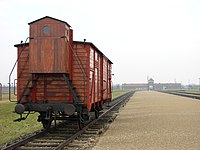Cattle wagon
A cattle wagon or a livestock wagon is a type of
Background
Moving live animals, particularly cattle and horses by rail, has occurred since the foundation of the railways, but few cattle or horse wagons survive due to the acidic nature of
livestock wagons with slatted sides and/or hutches. Originally high-sided wagons were also used to move cattle as well as horses and pigs. For the transport of military horses in goods wagons, tethering rings were fitted.[2] The transportation of large and small animals required special fittings – air vents, means of tethering, drinking facilities and viewing ports – in order to avoid quantitative and qualitative losses.[3]
Even troops were transported in covered goods wagons.
- Cattle wagons
-
Early example of a cattle wagon preserved on the Severn Valley Railway
-
Cattle wagon Alice Springs
-
Hc Class cattle wagon HC1018 and ganger's hut (on loading bank) at Little River Station. A notable omission are the running boards that should be on top of the roof.
UK racehorse transportation
Horse box
S96403As horse racing became a serious business based on science from the 17th century onwards, transport of
racehorses became a lucrative business. Having started using slow horse-drawn carts on muddy roads, in the late 19th century railways became a viable option for shipping racehorses quickly over longer distances. It also meant that racehorses could attend more meetings in better condition. However, railway companies used the same open and roughly built wagons for shipping racehorses that they used for cattle. In 1905, former president of the Royal College of Veterinary Surgeons J Wortley Axe wrote that loud conditions on board and short tethers used to restrain the animals seemed intentionally designed to spook horses. Hence the stables and railway companies introduced the protective leg wraps, shipping blankets, and head bumpers which are common today.[4]
After World War 2, whilst the need to transport live cattle decreased in the UK, with no
Investiture of the Prince of Wales at Caernarfon; the Royal Horse Artillery to Ludgershall; the King's Troop to Holyhead; and a touring company of the Royal Canadian Mounted Police. With decreasing railway access to many horse racing tracks, and a change in BR policy on animals and their transportation, the wagons were withdrawn in 1972, the last live animals carried on British railways.[5]
Use for deportation
Given their dimensions and features, cattle wagons have been used as vehicles for forced mass transfer and
their allies, for the purpose of forcible deportation of the Jews, as well as other victims of the Holocaust, to the German Nazi concentration, forced labour, and extermination camps.[6][7]
- Deportation wagons
-
Wagon withOswiecim- Poland.
-
People being deported in cattle wagons cars during World War II
-
A cattle wagon used for the transport of Belgian Jews to camps in Eastern Europe. The openings were covered in barbed wire.[8] This example is preserved at Fort Breendonk.
-
Interior of a covered goods wagon used to transport Jews and other Holocaust victims, the United States Holocaust Memorial Museum in Washington, D.C.
Cattle wagons were used for
forced settlement and population transfer in the Soviet Union
in the mid-20th century.
Following the end of World War II in Europe, ethnic Germans were expelled from Czechoslovakia in cattle wagons.
See also
- Horse wagon
- Livestock trailer
- Stock car (rail)
References
- ^ Tierbeförderung at Zeno.org. Article by: Viktor von Röll (ed.): Enzyklopädie des Eisenbahnwesens (Encyclopaedia of the Railway), 2nd edition, 1912–1923, Vol. 9, p. 319ff.
- ^ Güterwagen at Zeno.org. Article by: Viktor von Röll (ed.): Enzyklopädie des Eisenbahnwesens (Encyclopaedia of the Railway), 2nd edition, 1912–1923, Vol. 6, p. 19, 26f
- ^ Güterwagen at Zeno.org. Article by: Viktor von Röll (ed.): Enzyklopädie des Eisenbahnwesens (Encyclopaedia of the Railway), 2nd edition, 1912–1923, Vol. 6, p. 28f
- ^ "A Brief History on Horse Transport". Horse Network. 20 September 2017. Retrieved 8 January 2022.
- ^ "BR Horse Box S96403". Buckinghamshire Railway Centre. Retrieved 8 January 2022.
- ISBN 978-0202366111.
Bureaucrats in the Reichsbahn performed important functions that facilitated the movement of trains. They constructed and published timetables, collected fares, and allocated cars and locomotives. In sending Jews to their death, they did not deviate much from the routine procedures they used to process ordinary train traffic.
- ISBN 978-1845459277.)
{{cite book}}: CS1 maint: multiple names: authors list (link - ISBN 978-0-8021-1766-3.
Wikimedia Commons has media related to Cattle wagons.






![A cattle wagon used for the transport of Belgian Jews to camps in Eastern Europe. The openings were covered in barbed wire.[8] This example is preserved at Fort Breendonk.](http://upload.wikimedia.org/wikipedia/commons/thumb/f/f1/Breendonk071.jpg/180px-Breendonk071.jpg)
